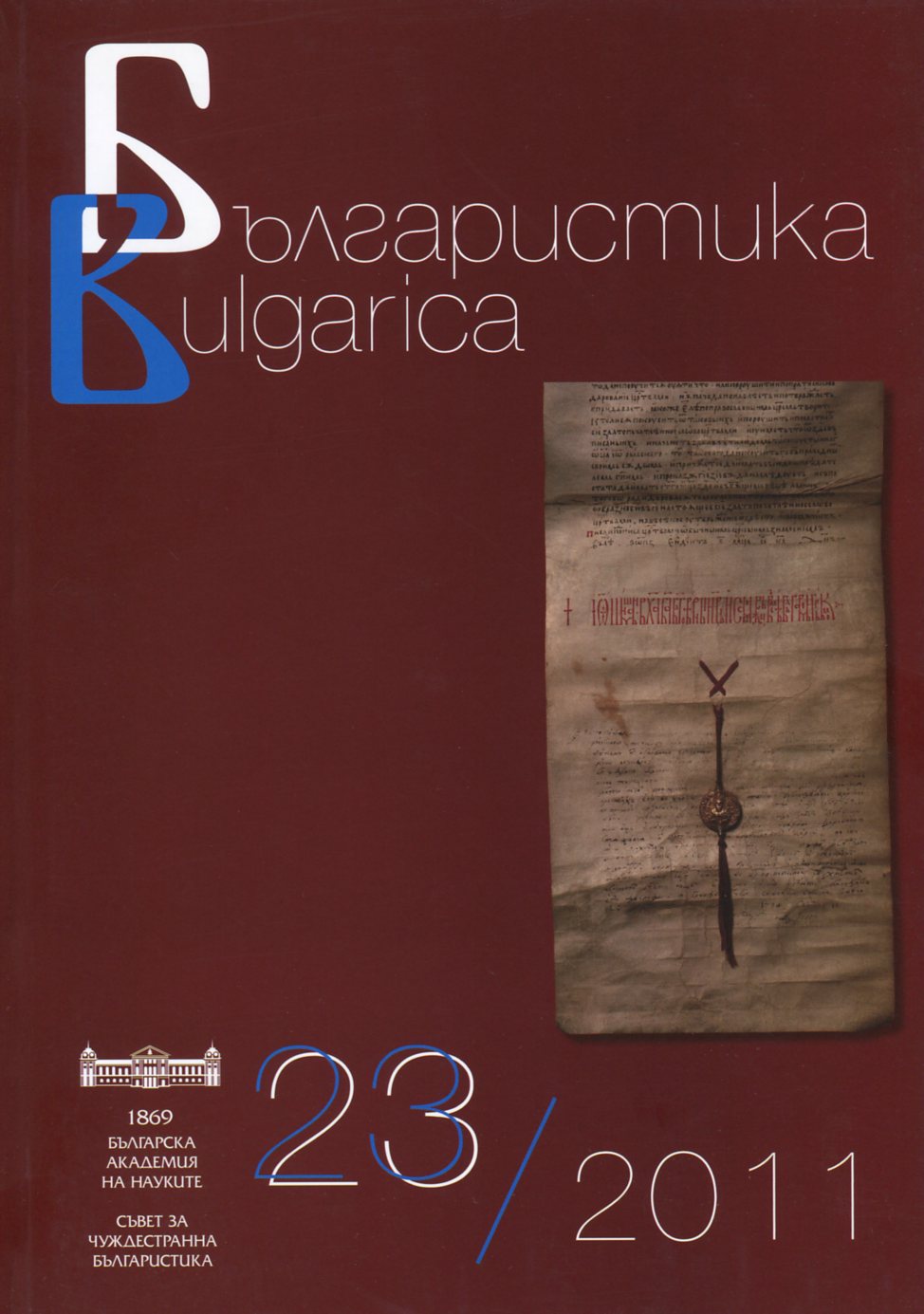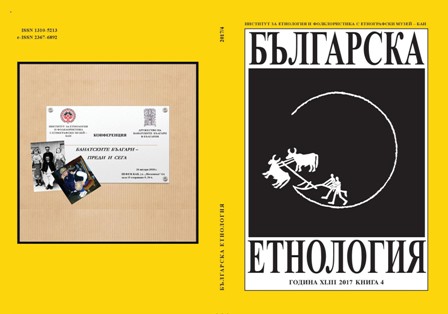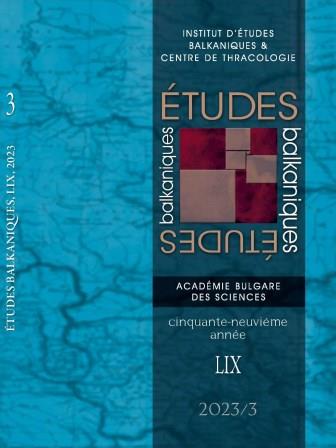
Книги 2014–2015 г.
Selected bibliography in the field of Bulgarian Studies published in 2014-2015
More...We kindly inform you that, as long as the subject affiliation of our 300.000+ articles is in progress, you might get unsufficient or no results on your third level or second level search. In this case, please broaden your search criteria.

Selected bibliography in the field of Bulgarian Studies published in 2014-2015
More...
Selected bibliography in the field of Bulgarian Studies published in 2015-2016
More...
Selected bibliography in the field of Bulgarian Studies published in the current year.
More...
Content of the main Bulgarian scientific journals for the current year in linguistics, literature, history, folklore, ethnography, archaeology and art studies
More...
Selected bibliography in the field of Bulgarian Studies published in the current year
More...
One of the typical and relatively stable features of the everyday life of the Bulgarianimmigrants in the historical and cultural region of Bessarabia are the patronal festivalsand customs held within the frameworks of the village, neighbourhood or familyand referred to as zbor/sabor (збор/събор), hram (храм), kurban (курбан), tsarkva(църква), panagir (панагирь), cherkuvane (черкуване), moleben (молебен) etc. Asfor the designation збор (a fair), it is clear that it precedes the Russian designationхрам (a patron saint’s day) which penetrates the region under study later on andwhich is widely used at present. What stirs up bigger interest is the fact that exceptfor village church festivals this term (as well as some of the other above-mentioned) was also used for intervillage festivals held at the landmark of the territories of two,three or more villages – the so-called fairs at the landmark also known as moleben orcherkuvane for rain and good health.As far as the patron saint’s day is a universal Christian phenomenon and stilla general practice in the villages of the region studied here, it could be assumedthat the gathering itself, the making of zbor (or moleben) at the landmark (at theborder between a group of villages), which is neglected today almost everywhere,is a form typical only of the immigrants (Bulgarians and Gagauzians) in Bessarabia.This practice attracts the attention with respect to its nature and development as partof the all-Bulgarian system of patronal village festivals as well as with relation tothe influences, changes and specifics through which it inevitably goes under theconditions of the many-tounged and polycultural environment of Bessarabia and theRussian Orthodox Christianity.The fieldwork materials collected so far do not allow a coprehensive and thickdescription of the phenomena intriguing us as well as a more elaborate analysis.That’s why the article only poses the problem or rather interpretes it in connectionwith some concepts of the kin and family-territorial patronal festivals and customswhich were formulated a long time ago in the Bulgarian science but which are stillrelevant.
More...
On the basis of written sources and field materials, the article examines the phenomenonof the “Odessa cuisine” as a regional complex of food. In the context of thehistorical dynamics, it shows the role of the Balkan traditions in the formation anddevelopment of the everyday culture of the inhabitants of Odessa. Special attentionis paid to the current state of the trade subculture and, respectively, to the systemof the food traditions in Odessa. In particular, the article shows that there are manyproducts introduced by natives from the Balkans (first of all, Greeks and Bulgarians):eggplants, tomatoes, cheese, corn, mutton, grapes, etc. The regional dishes perceivedas “Odessaian” but having roots in the ethno-cultures of the above-mentioned communities,are developed on this basis. The text shows also the “blue” (eggplants) invarious variations of preparation and the “pshonka” (corn). Beside the national, theprofessional mass cuisine is also analyzed (restaurant); in it the Balkan substratumhas found its place a long time ago along with the Jewish, Ukrainian and Moldavian.In the menu of these institutions, there are surely a number of dishes with Balkanorigins. On the other hand, it is worth characterizing the special national restaurantsof Odessa (Bulgarian, Gagauzian, Greek).
More...


In this article the application of Sharia law over the Muslim population of Vardar Macedonia is demonstrated. The application of Sharia Law form the establishment of Ottoman rule until the end of the Second World War is directly related to functioning of state Sharia courts. In this era the Sharia law is part of the positive law. With the change in the historical and political context in the aftermath of First World War, the Sharia court have been included in the Yugoslavian secular state as a structure, relatively independent form the Muslim religious authority, which is based on principles of spiritual hierarchy. Its application have had a positive impact, preserving the Muslim population`s identity. After the Second World War the Sharia court are dismissed. From the legal-normative point of view it is not possible to state that this is Sharia law, because there is a lack of state coercion, which is one of the prerequisites to talk about law. After this point, the essence of sharia ruling is preserved via moral relations and obligations, customs and traditions and the work of the religious institutions as well.
More...
On the basis of unpublished source material, the present text attempts to reconstruct the administrative procedures through which the request of the Malaysian Bulgarians living in the villages of Kodjubunar and Aladjabaira must be passed before a statuary is issued with permission to build or repair an Orthodox temple.
More...
The Scientific Archives of the Bulgarian Academy of Sciences began its work with the foundation of the Bulgarian Literary Society in Braila in September 1869. Its task is to find, process and offer for use all the materials on the history of the scientific thought in Bulgaria and the history of the BAS. The Scientific Archive preserves the archival documents of the institutes of the BAS as well as the personal collections of academicians, corresponding members and professors; it does scientific and technical processing, estimates the value of the archival documents and restores them. The archive organizes the use of the archival documents for scientific research, reference and other purposes, prepares documentary publications and exhibitions of documents.The cultural heritage preserved in the BAS is a national treasure and we are responsible for its protection.This article examines only archival collections with ethnographic materials and researches. It is an invitation to researchers for future studies.
More...

The türbe of Elmalı baba in the village of Bivolyane is probably the most visited by the Heterodox Muslim Turks place of pilgrimage in Eastern Rhodopi Mountains in Bulgaria. Nevertheless, there is no information about a narrative dedicated to the worship of the saints there. Most probably the reason for that is connected to two traumatic events: the closing of the türbe by Sultan Mahmud II in 1826 and the forceful change of the names of the Turks in Bulgaria in 1984–1985. The article offers a hypothesis explaining the existence of an extremely rare co-presence of six (considered male) and one (worshiped as female) graves, which have appeared in the period between these two traumatic moments.
More...

Based on a politico-economic analysis, the paper provides answers to important questions about the April Uprising of 1876: why the Bulgarians revolted, why many Bulgarians did not revolt, and why the uprising was relatively short as a time-span. According to the available primary sources the Bulgarians who revolted in April 1876 revolted because they were relatively wealthy and as such they had something to lose. Revolutionary sentiments, however, did not prevail in their political views concerning the Bulgarian question. Here comes the role of the propaganda lie about the authority planned massacre of the Bulgarians. As a result, live and property of the future rebels, were considered as endangered. The response to the threat is a risky and desperate anti-state uprising. The organizers of the uprising did not overcome the free-rider problem. The population in the insurgent settlements was left to pay the price of putting the Bulgarian question before Europe. Additional difficulties in the implementation of a relatively mass riot pose the short deadlines for its preparation. They resulted in high prices of and do not allow the supply of larger quantities of weapons and gunpowder.
More...
After 1517 the Holy Places of Jerusalem, Palestine and Sinai as well as the three ancient Eastern Patriarchates of Alexandria, Antiochia and Jerusalem were included into the imperial domain of the Sublime Porte thus connecting its Orthodox subjects in Rumelia, Greek islands, Asia Minor and the Danubian Principalities to the most worshipped common Christian shrines. In the following two centuries the number of the pilgrims to the Holy Land from the Ottoman Balkan provinces was permanently increasing. The South Slav pilgrims’ glosses and travel notes reveal the shaping of the common orthodox space, the parts of which were the visitors’ living places, sacral centers, monasteries and travel communications. The pilgrimage to Jerusalem and the return back lead them across administrative, canonical, ethnic and territorial metes and bounds creating in their minds the image of the Ottoman Empire as mighty world power with multinational and multi-confessional population thus laying foundations for the development of protonational identities.
More...
The article focuses on imperial policies towards provincial elites in the Balkans and Asia Minor in three major empires which succeeded one another, namely the Roman, the Byzantine, and the Ottoman. Provincial elites were important for imperial power as intermediaries between local communities and central authorities. Our article adopts a political and institutional approach, and focuses on provincial elites as agents who were given formal or informal shares in the mechanisms and hierarchies through which empires were governed. Following surveys of imperial policies towards provincial elites in the three polities, it argues that, unlike the concept of empire which can be universal, imperial systems of government are neither uniform nor static, and depend on such factors as state ideology, historical circumstances, and political and economic exigencies. Ultimately, our article demonstrates how structural differences in the very conception of imperial governance and ideology resulted in differentiated policies towards provincial elites.
More...
The article tries to shed light on the following three questions: what were the goals of the Jewish Zionist leaders in the conflict with Palestinians? What was the process of breaking out the conflict between Jews and Palestinians? What was the conflict over the years? The answerers come from Jewish Israelis, which I analyze based on the academic literature. The well-defined idea to settle Jews in their old homeland appeared with the emergence of Zionism. It was a revolutionary ideology since Jews left/were expelled from their country about 2000 years ago. But there was one problem that stood as a barrier. There were Palestinians living in the same place, some for centuries, who also began to develop their nationalism. This fact opened an intractable conflict between Jews and Palestinians that had lasted for over a hundred years until present time. The article points out to the most important events and processes that shaped the conflict from escalation to de-e scalation and again to re-escalation.
More...
After its founding, the Turkish Republic kept its distance from Arab affairs. During the interwar period, Türkiye worked to develop its own national identity while maintaining a balance between imperialist and revisionist powers. After WWII, Türkiye, threatened by Soviets, joined NATO whereas the newly independent Middle Eastern states viewed Russia as an anti-colonialist friend. The coming of détente and changes in Turkish economic policy toward export-led growth, guided Türkiye to develop closer economic relations with its neighbors. Its clear foreign policy rule, however, was not getting involved in the politics of any Arab country or in inter-Arab matters. The Arab Spring led the religiously oriented AKP to judge that Türkiye could lead Sunni-majority countries. Facing total failure, Türkiye is trying to restore former relations with regional countries but lacking trust, this is a slow and only partially successful process.
More...